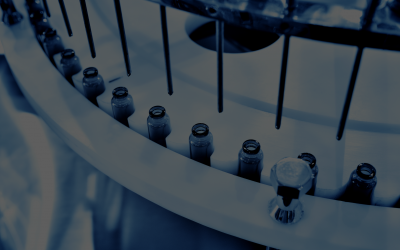Accurate impact force measurement in bottling and packaging is crucial for grasping the root cause of shocks, especially those quantified in Inches Per Second (IPS). It equips fillers with the knowledge to improve line efficiency and minimize container damage.
Let’s look at the concepts behind impact force measurement, demystify the IPS rating, and identify the real-world applications of these principles.
Unpacking the IPS Rating: From Basics to Breakage Probabilities
Impact force directly affects the quality, safety, and durability of the container. An accurate measurement ensures that potential areas of weakness are identified and addressed, paving the way for improved efficiency and minimized waste.
What is Impact Force?
Impact force refers to the amount of force exerted when two objects collide. In the context of bottling and packaging, it’s the force experienced by a container when it comes into contact with another object or surface. This force is influenced by factors such as the speed and angle of collision, as well as the materials and designs of the interacting entities.
At its core, impact force measurements provide insights into potential vulnerabilities in a container’s design and materials. When a bottle, for instance, encounters an external force, such as when it’s being filled, sealed, or transported, it undergoes stresses that could lead to breakage or other damage. By understanding and quantifying these forces, engineers and designers can optimize packaging to be more resilient and efficient throughout its lifecycle.
What is an IPS Rating?
The IPS rating, in layman terms, can be understood as the resilience certificate of a bottle. But what does it actually denote?
An IPS rating stands as a testament to a bottle’s strength. Specifically, it implies the likelihood of a bottle’s breakage when struck by an object of a known mass. It’s crucial to grasp that the IPS rating is not a conclusive decree of breakage. Rather, it’s an indicator of the increasing likelihood of breakage as the force of impact rises.
Let’s look at a scenario: Consider a bottle designed with an IPS rating of 20, signifying a breakage probability of 1 in every 10,000 units. If, however, this bottle encounters an impact force of 25 IPS, it may endure unscathed. But, the breakage probability amplifies to 5 in every 10,000 units. That’s a fivefold surge in risk.
The Evolution of IPS and Impact Force Measurement
Long confined to the realms of glass bottle producers and largely overlooked by fillers, the significance of IPS measurements is gaining traction. In today’s age, where lightweight bottle designs are in vogue, ensuring they remain sturdy against impacts on the line is paramount. This underlines IPS’s pivotal role in accurate impact force measurement – and the opportunity for technology to improve container performance.
IPS – Bridging the Gap Between Lab Theories and Real-world Impacts
Laboratory settings, while controlled and standardized, can sometimes fall short of capturing the full spectrum of challenges a bottle might face in a real-world production line. Variables such as speed of movement, interaction with machinery, temperature fluctuations, and even human intervention can substantially alter the way a container responds to impact.
A bottling or packaging line, teeming with these complexities, becomes a challenging environment where the behavior of materials can vary from the predicted outcomes seen in lab tests. This is where a dynamic IPS (Inches Per Second) measurement like Masitek’s ShockQC sensor proves its worth.
By taking into account the practical realities of a production line, sensor-based impact force measurement offers a middle ground. It provides a framework that incorporates lab-based knowledge while adjusting for the unpredictabilities of a real-world environment.
This flexibility of sensor-based impact force measurement makes it invaluable for both glass manufacturers and fillers. For glass manufacturers, it offers insights into how their products might fare once they leave the controlled confines of the lab. On the other hand, fillers can benefit from this dynamic approach to IPS calculation by obtaining data that’s more reflective of on-the-ground conditions, ensuring their processes align more closely with actual bottle behavior rather than theoretical predictions.
With the continual advancement of technology and increasing demand for efficiency, a system like IPS, which bridges the gap between lab theories and real-world impacts, is not just useful; it’s indispensable.
The Future of Impact Measurement: Dynamic IPS Calculation
Technology’s rapid advancement has ushered in novel methods to measure IPS, allowing for more real-time, dynamic calculations. By transitioning out of static lab environments into bustling production lines, teams are equipped to with insights that are both immediate and actionable.
Diving Deeper: Methods of Measuring Impact Force and Dynamic IPS Calculation
Measuring impact force isn’t limited to mere IPS ratings; it’s a dynamic world where physics meets practical application.
The Technicalities of Measuring Impact Force
While we often understand IPS in its basic terms, there’s a complex physics principle that underpins the entire process. When measuring impact force, the method involves integrating the acceleration waveform to ascertain the area beneath the curve. This results in a measurement unit termed velocity, such as IPS.
To integrate this waveform, high-frequency data is imperative. A standard waveform, resulting from an impact on a bottle, spans approximately 1.5 to 2 milliseconds. Hence, obtaining 80 to 100 samples per millisecond, which translates to 80,000 to 100,000 samples per second, is essential to accurately capture this waveform.
For instance, observe the Freestanding Impact Acceleration Graph below. In this representation, a bottle undergoes impact force from a pendulum, resulting in an IPS rating of 47 IPS. What’s fascinating is the difference between the bottle’s speed after impact (18 in/sec) and the speed at which the pendulum was traveling when it hit the bottle (47 IPS).

It’s this disparity that showcases the law of conservation of momentum, elucidating that the bottle’s mass was significantly greater than the pendulum weight. Companies adopt various techniques to test bottles, like the pendulum method, X-Ray Fluorescent Spectrometer, and Scanning Electron Microscope, among others. The evolution of in-line sensors, however, has opened new doors to accurately measure this impact force.
The Challenge of Lab Testing versus Real World Dynamics
Every bottle is uniquely constructed, having different sections like heels, shoulders, and necks. The impact’s location on the bottle is as pivotal as the magnitude of the impact. For example, while a bottle’s body might be more forgiving to impacts, its shoulder or heel might not be.
Quoting Kiy L. Yam from The Wiley Encyclopedia of Packaging Technology: “Various strengths exist for different parts of the bottle. Also, strengths for momentary loading, such as for impacts during handling, are significantly different than those for long sustained loads.”
In reality, in-line sensors play a critical role by not only detecting where the damaging impact force occurs on a production line but also pinpointing the exact locations on the bottle subjected to varying pressures. These sensors are designed to replicate the actual bottle’s journey along the production line, collecting valuable data dynamically via a thin sensor film. Collecting real-time datasets, they offer a real-time snapshot, helping operators identify potential pressure zones and the resultant impact force on the containers.
Feedback from the Field on Impact Force Sensors
To put the importance of in-line sensors into perspective, consider the insights provided by Jane Tinning, Carlsberg’s Senior Packaging Expert: “Where glass breakage occurs is not necessarily the highest or only high-impact area.”
Carlsberg’s adoption of in-line sensors shed light on an essential observation: It wasn’t always the most intense impact force that caused breakages. Often, minor damages weakened the glass structure, making it susceptible to even minimal downstream impacts. Without the impact force sensors, identifying these vulnerabilities would’ve been a challenge.
Embracing the Future: Leveraging IPS Measurements for Optimal Efficiency
As the world of bottling and packaging evolves, so do the technology and methodologies associated with it. By understanding and adapting to these advanced IPS measurement techniques, bottling engineers can ensure that their products not only meet but exceed the stringent quality standards set by the industry. Whether you’re a seasoned professional or just starting in the field, a thorough grasp of these concepts is your ticket to creating safer, more efficient, and more resilient products.
Key Takeaways
- Impact force measurement and understanding IPS are pivotal for bottling and packaging.
- IPS ratings offer insights into a bottle’s resilience against impacts.
- Advanced methods, including in-line sensors, provide a more real-world perspective of impact forces on bottles, bridging the gap between lab theories and real-world applications.
- Embracing these methodologies ensures better product durability and production efficiency.
By delving deep into the technicalities, bottling engineers can remain at the forefront of industry advancements, ensuring their products stand the test of time and real-world pressures.
The Vidrala Impact Index: A New Benchmark in Impact Measurement
While understanding IPS is paramount, the Vidrala Impact Index (VII) offers another lens through which we can evaluate impact force.
What Exactly is the Vidrala Impact Index?
Whenever a container navigates through the filling line, it’s subjected to a multitude of impacts, each varying in intensity. The VII serves as a reflection of these impacts. It quantifies the number of strikes, each equivalent to the bottle’s IPS rating, that would yield a similar breakage probability.
To illustrate, if a line has a Vidrala Impact Index of 22, it signifies that all the impacts a glass bottle experiences during filling would elevate its breakage likelihood equivalent to being struck 22 times at a force matching its IPS rating.
FAQ on Impact Force Measurement
Why measure impact force on the line?
- Measuring impact force on the production line offers real-time insights into potential vulnerabilities in the production process. It aids in reducing breakages and improving efficiency.
How do sensors measure impact force?
- Sensors, particularly in-line sensors, detect areas of high impact and pressure by traveling alongside the bottles on the production line. Their high sampling rates capture the acceleration waveform, which can be integrated to determine the impact force.
What does IPS mean?
- IPS stands for Inches Per Second and is a measurement unit used in the glass industry to indicate the strength of a bottle. Here’s more information on what IPS means and why it is an important impact force measurement.
Navigating the complexities of impact force, IPS ratings, and their implications in the bottling and packaging world is crucial. With evolving technology and measurement tools, bottling and packaging businesses can ensure their glass packaging is resilient and ready for the challenges of the production line.
Interested in enhancing your production efficiency? Explore the intricacies of impact force measurement and see how advanced metrics can offer valuable insights into efficiency and quality improvements.






